The royal visit
The visit to Australia by the Duke of York in 1901 was the first by a British heir-apparent, and it was the occasion of a frenzy of social activity, in which the Duke and Duchess were feted in parades, reviews, balls, dinners, concerts and a range of ceremonies. The royal visit became, in the minds of many, a much larger event than that which was the purpose of the visit; namely, the opening of the first Commonwealth Parliament.
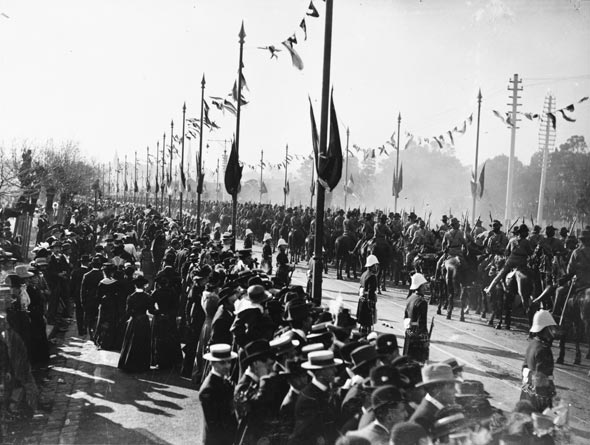 |
The procession of 6 May, 1901
National Library of Australia |
Members of the royal party travelled to Australia on the royal yacht Ophir, which departed from Portsmouth on 16 March. They formally arrived in Melbourne on St Kilda pier at 2.00pm on 6 May, and immediately afterwards took part in a grand procession which travelled along St Kilda Road to the centre of Melbourne, past the front of Parliament House, and to Government House. Mounted troops from all Australian states and New Zealand participated in the procession, which was almost two kilometres long and took two hours to pass some points of the seven kilometre route.
The streets of Melbourne were lined with half a million spectators, many of whom had bought tickets to sit in wooden stands erected two or three stories high. People spilled from every window, step and vantage-point, waving flags and cheering. Thirty-five thousand school children waved union jacks and sang ‘God save the King’ and ‘God Bless the Prince of Wales’ from the slopes of the Domain.
 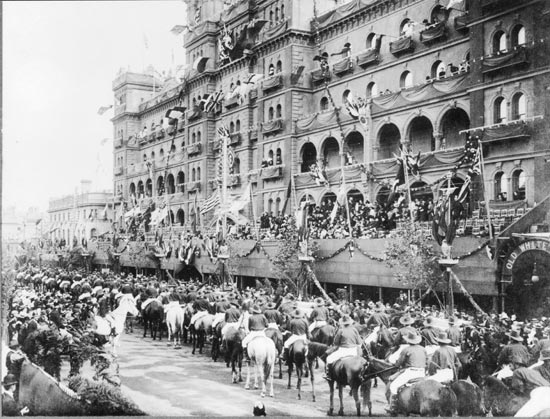 |
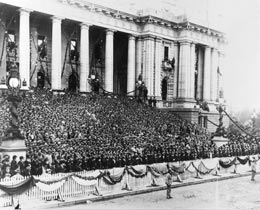 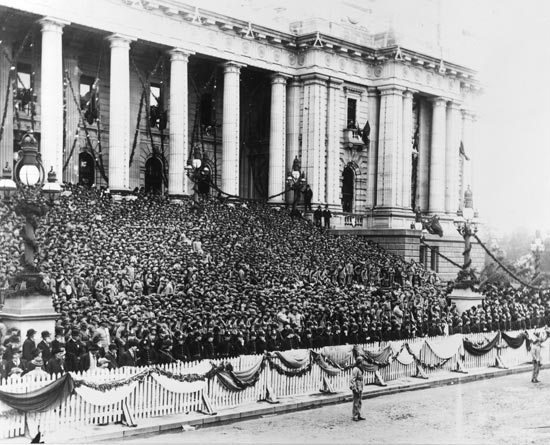 |
Stockmen's Procession
National Library of Australia
Stockmen's procession passing along Spring Street, Melbourne, 6 May 1901. |
Cadets at Parliament House
National Library of Australia
Fifteen hundred cadets assembled on the steps of Parliament House to cheer the Duke and Duchess as they passed. |
A reporter for the Sydney Morning Herald who watched the procession from the roof of Parliament House wrote of:
Dense masses of people along every thoroughfare, packed so closely that the streets as far as the eye could reach were rolling billows of humanity, unceasing in motion and capped by a flying spray of flags and handkerchiefs.
The streets were decorated with giant festive arches and miles of bunting and thousands of flags on masts, placed on each side of the tramways.
 |
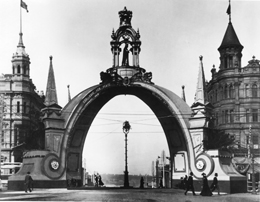 |
| The King's Arch, Swanston Street
National Library of Australia |
Queen Victoria Arch, Collins Street
National Library of Australia |
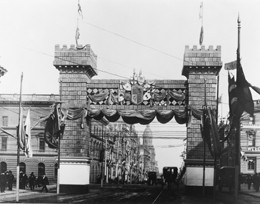 |
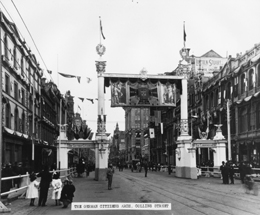 |
The Butter Arch, Collins Street
National Library of Australia |
The German Arch, Collins Street
National Library of Australia |
'The procession passed under the King's arch, in Swanston-street, turned into Collins-street, and passing under the Queen Victoria arch thence went along Spring-street to Parliament house and down Bourke-street, passing under the Citizen's arch, and the Duke of York's arch to William-street. Then turning into Collins-street it passed under the Butter arch and German arch, and on reaching Swanston-street, passed over the Prince's Bridge to Government House …’
The crowd turned out again on 9 May to cheer the Duke and the Governor-General as they passed on their way to the opening of Parliament, escorted by 116 Australian mounted troops.
|


